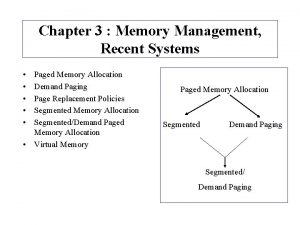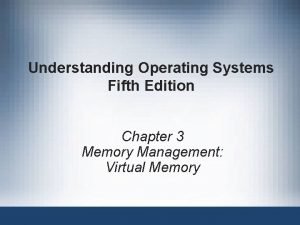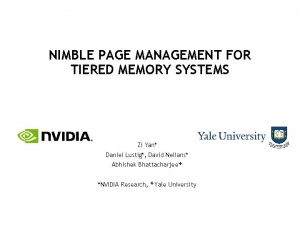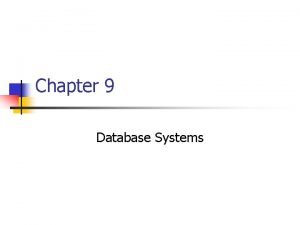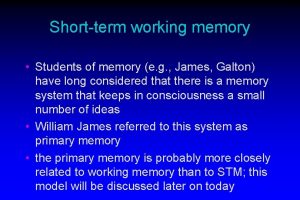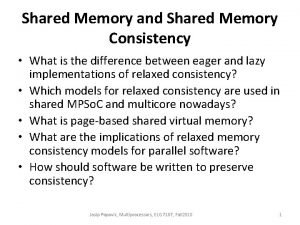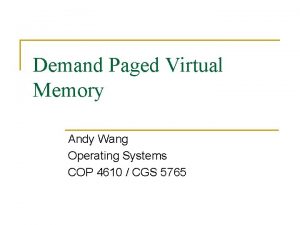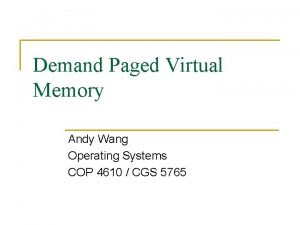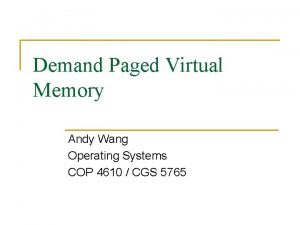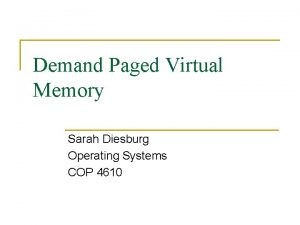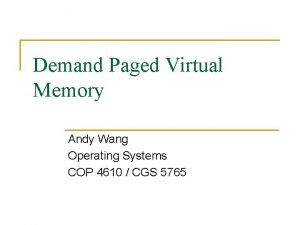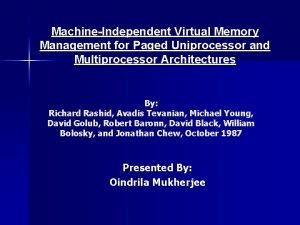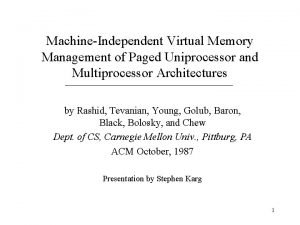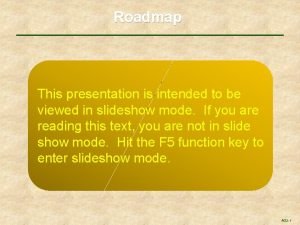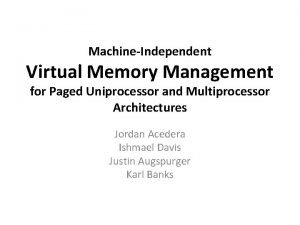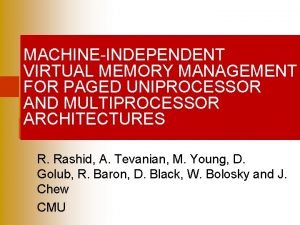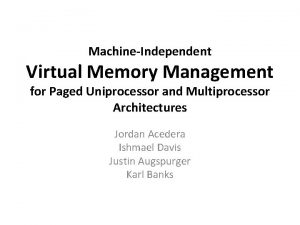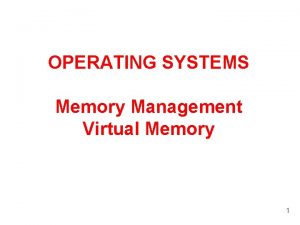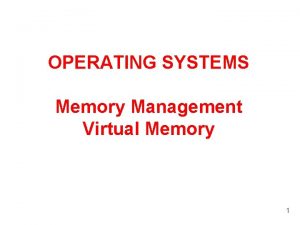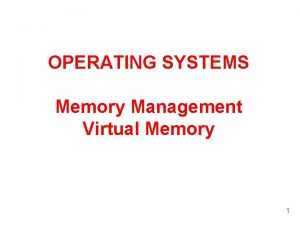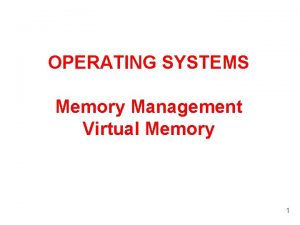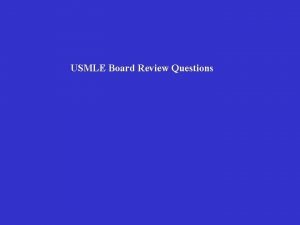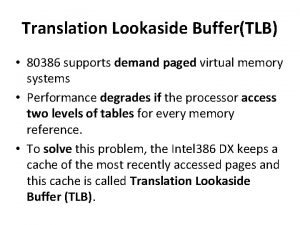Chapter 3 Memory Management Recent Systems Paged Memory











































- Slides: 43

Chapter 3 : Memory Management, Recent Systems • • • Paged Memory Allocation Demand Paging Page Replacement Policies Segmented Memory Allocation Segmented/Demand Paged Memory Allocation • Virtual Memory Paged Memory Allocation Segmented Demand Paging Segmented/ Demand Paging

Memory Management • Early schemes were limited to storing entire program in memory. – Fragmentation. Problems – Overhead due to relocation. • More sophisticated memory schemes now that: – Eliminate need to store programs contiguously. – Eliminate need for entire program to reside in memory during execution. Understanding Operating Systems 2

More Recent Memory Management Schemes • Paged Memory Allocation • Demand Paging Memory Allocation • Segmented/Demand Paged Allocation Understanding Operating Systems 3

Paged Memory Allocation • Divides each incoming job into pages of equal size. • Works well if page size = size of memory block size (page frames) = size of disk section (sector, block). Before executing a program, memory manager: 1. Determines number of pages in program. 2. Locates enough empty page frames in main memory. 3. Loads all of the program’s pages into them. Understanding Operating Systems 4

Programs Are Split Into Equal-sized Pages (Figure 3. 1) Understanding Operating Systems 5

Job 1 (Figure 3. 1) At compilation time every job is divided into pages: – Page 0 contains the first hundred lines. – Page 1 contains the second hundred lines. – Page 2 contains the third hundred lines. – Page 3 contains the last fifty lines. • Program has 350 lines. – Referred to by system as line 0 through line 349. Understanding Operating Systems 6

Paging Requires 3 Tables to Track a Job’s Pages 1. Job table (JT) - 2 entries for each active job. – Size of job & memory location of its page map table. – Dynamic – grows/shrinks as jobs loaded/completed. 2. Page map table (PMT) - 1 entry per page. – Page number & corresponding page frame memory address. – Page numbers are sequential (Page 0, Page 1 …) 3. Memory map table (MMT) - 1 entry for each page frame. – Location & free/busy status. Understanding OS 7

Job Table Contains 2 Entries for Each Active Job (Table 3. 1) Understanding Operating Systems 8

Job 1 Is 350 Lines Long & Divided Into 4 Pages (Figure 3. 2) 9

Displacement (Figure 3. 2) • Displacement (offset) of a line -- how far away a line is from the beginning of its page. – Used to locate that line within its page frame. – Relative factor. • For example, lines 0, 100, 200, and 300 are first lines for pages 0, 1, 2, and 3 respectively so each has displacement of zero. Understanding Operating Systems 10

To Find the Address of a Given Program Line • Divide the line number by the page size, keeping the remainder as an integer. Page number Page size line number to be located xxx Displacement Understanding Operating Systems 11

Address Resolution Each time and instruction is executed or a data value is used, the OS or (hardware) must: – Translate the job space address (relative). – Into a physical address (absolute). Understanding Operating Systems 12

Pros & Cons of Paging • Allows jobs to be allocated in non-contiguous memory locations. – Memory used more efficiently; more jobs can fit. • Size of page is crucial (not too small, not too large). • Increased overhead occurs. • Reduces, but does not eliminate, internal fragmentation. Understanding Operating Systems 13

Demand Paging • Bring a page into memory only when it is needed, so less I/O & memory needed. – Faster response. • Takes advantage that programs are written sequentially so not all pages are necessary at once. For example: – User-written error handling modules. – Mutually exclusive modules. – Certain program options are either mutually exclusive or not always accessible. – Many tables assigned fixed amount of address space even though only a fraction of table is actually used. Understanding Operating Systems 14

Demand Paging - 2 • Demand paging made virtual memory widely available. – Can give appearance of an almost-infinite or nonfinite amount of physical memory. • Requires use of a high-speed direct access storage device that can work directly with CPU. • How and when the pages are passed (or “swapped”) depends on predefined policies that determine when to make room for needed pages and how to do so. Understanding Operating Systems 15

Tables in Demand Paging • • Job Table. Page Map Table (with 3 new fields). – Determines if requested page is already in memory. – Determines if page contents have been modified. – Determines if the page has been referenced recently. – Used to determine which pages should remain in main memory and which should be swapped out. • Memory Map Table. Understanding Operating Systems 16

Page Map Table Understanding Operating Systems 17

Hardware Instruction Processing Algorithm • Start processing instruction • Generate data address • Compute page number • If page is in memory Then get data and finish instruction advance to next instruction return to step 1 Else generate page interrupt call page fault handler Understanding Operating Systems 18

Page Fault Handler Algorithm 1. If there is no free page frame Then Select page to be swapped out using page removal algorithm Update job’s page map table If content of page had been changed then Write page to disk End if 2. Use page number from step 3 from the hardware instruction processing algorithm to get disk address where the requested page is stored. 3. Read page into memory. 4. Update job’s page map table. 5. Update memory map table. 6. Restart interrupted instruction. 19

Thrashing Is a Problem With Demand Paging • Trashing – an excessive amount of page swapping back and forth between main memory and secondary storage. – Operation becomes inefficient. – Caused when a page is removed from memory but is called back shortly thereafter. – Can occur across jobs, when a large number of jobs are vying for a relatively few number of free pages. – Can happen within a job (e. g. , in loops that cross page boundaries). • Page fault – a failure to find a page in memory. Understanding Operating Systems 20

Page Replacement Policies • Policy that selects page to be removed is crucial to system efficiency. – Selection of algorithm is critical. • First-in first-out (FIFO) policy* – best page to remove is one that has been in memory the longest. • Least-recently-used (LRU) policy* – chooses pages least recently accessed to be swapped out. • Most recently used (MRU) policy. • Least frequently used (LFU) policy. Understanding Operating Systems * Most well known policies 21

FIFO policy. When program calls for Page C, Page A is moved out of 1 st page frame to make room for it (solid lines). When Page A is needed again, it replaces Page B in 2 nd page frame (dotted lines). Understanding Operating Systems 22

How each page requested is swapped into 2 available page frames using FIFO. When program is ready to be processed all 4 pages are on secondary storage. Throughout program, 11 page requests are issued. When program calls a page that isn’t already in memory, a page interrupt is issued (shown by *). 9 page interrupts result. Understanding Operating Systems 23

FIFO • High failure rate shown in previous example caused by: – limited amount of memory available. – order in which pages are requested by program (can’t change). • There is no guarantee that buying more memory will always result in better performance (FIFO anomaly or Belady's anomaly). Understanding Operating Systems 24

LRU Policy For program in Figure 3. 8. Throughout the program 11 page requests are issued, but they cause only 8 page interrupts. Understanding Operating Systems 25

LRU • The efficiency of LRU is only slightly better than with FIFO. • LRU is a stack algorithm removal policy – increasing main memory causes either a decrease in or same number of page interrupts. – LRU doesn’t have same anomaly that FIFO does. Understanding Operating Systems 26

Mechanics of Paging : Page Map Table • Status bit indicates if page is currently in memory or not. • Referenced bit indicates if page has been referenced recently. – Used by LRU to determine which pages should be swapped out. • Modified bit indicates if page contents have been altered – Used to determine if page must be rewritten to secondary storage when it’s swapped out. Understanding Operating Systems 27

Four Possible Combinations of Modified and Referenced Bits Modified Referenced Meaning Case 1 0 0 Not modified AND not referenced Case 2 0 1 Not modified BUT was referenced Case 3 1 0 Was modified BUT not referenced (impossible? ) Case 4 1 1 Was modified AND referenced Understanding Operating Systems 28

Page Replacement : The Working Set • Working set – set of pages residing in memory that can be accessed directly without incurring a page fault. – Improves performance of demand page schemes. • Locality of reference occurs with well-structured programs. – During any phase of its execution program references only a small fraction of its pages. • System must decide: – How many pages comprise the working set? – What’s the maximum number of pages the operating system will allow for a working set? Understanding Operating Systems 29

Pros & Cons of Demand Paging • First scheme in which a job was no longer constrained by the size of physical memory (virtual memory). • Uses memory more efficiently than previous schemes because sections of a job used seldom or not at all aren’t loaded into memory unless specifically requested. • Increased overhead caused by tables and page interrupts. Understanding Operating Systems 30

Segmented Memory Allocation • Based on common practice by programmers of structuring their programs in modules (logical groupings of code). – A segment is a logical unit such as: main program, subroutine, procedure, function, local variables, global variables, common block, stack, symbol table, or array. • Main memory is not divided into page frames because size of each segment is different. – Memory is allocated dynamically. Understanding Operating Systems 31

Segment Map Table (SMT) • When a program is compiled, segments are set up according to program’s structural modules. • Each segment is numbered and a Segment Map Table (SMT) is generated for each job. – Contains segment numbers, their lengths, access rights, status, and (when each is loaded into memory) its location in memory. Understanding Operating Systems 32

Tables Used in Segmentation • Memory Manager needs to track segments in memory: • Job Table (JT) lists every job in process (one for whole system). Segment Map Table lists details about each segment (one for each job). Memory Map Table monitors allocation of main memory (one for whole system). • • Understanding Operating Systems 33

Pros & Cons of Segmentation • Compaction. • External fragmentation. • Secondary storage handling. • Memory is allocated dynamically. Understanding Operating Systems 34

Segmented/Demand Paged Memory Allocation • Evolved from combination of segmentation and demand paging. – Logical benefits of segmentation. – Physical benefits of paging. • Subdivides each segment into pages of equal size, smaller than most segments, and more easily manipulated than whole segments. • Eliminates many problems of segmentation because it uses fixed length pages. Understanding Operating Systems 35

4 Tables Are Used in Segmented/Demand Paging • • Job Table lists every job in process (one for whole system). Segment Map Table lists details about each segment (one for each job). – E. g. , protection data, access data. Page Map Table lists details about every page (one for each segment). – E. g. , status, modified, and referenced bits. Memory Map Table monitors allocation of page frames in main memory (one for whole system). Understanding Operating Systems 36

Pros & Cons of Segment/Demand Paging • Overhead required for the extra tables • Time required to reference segment table and page table. • Logical benefits of segmentation. • Physical benefits of paging • To minimize number of references, many systems use associative memory to speed up the process. Understanding Operating Systems 37

Virtual Memory (VM) • Even though only a portion of each program is stored in memory, virtual memory gives appearance that programs are being completely loaded in main memory during their entire processing time. • Shared programs and subroutines are loaded “on demand, ” reducing storage requirements of main memory. • VM is implemented through demand paging and segmentation schemes. Understanding Operating Systems 38

Comparison of VM With Paging and With Segmentation Understanding Operating Systems 39

Advantages of VM • • Works well in a multiprogramming environment because most programs spend a lot of time waiting. Job’s size is no longer restricted to the size of main memory (or the free space within main memory). Memory is used more efficiently. Allows an unlimited amount of multiprogramming. Eliminates external fragmentation when used with paging and eliminates internal fragmentation when used with segmentation. Allows a program to be loaded multiple times occupying a different memory location each time. Allows the sharing of code and data. Facilitates dynamic linking of program segments. Understanding Operating Systems 40

Disadvantages of VM • Increased processor hardware costs. • Increased overhead for handling paging interrupts. • Increased software complexity to prevent thrashing. Understanding Operating Systems 41

Key Terms • • address resolution associative memory demand paging displacement FIFO anomaly first-in first-out (FIFO) policy Job Table (JT) least-recently-used (LRU) policy • locality of reference • Memory Map Table (MMT) Understanding Operating Systems • • • page fault handler page frame Page Map Table (PMT) page replacement policy page swap paged memory allocation reentrant code segment Segment Map Table (SMT) 42

Key Terms - 2 • segmented memory allocation • segmented/demand paged memory allocation • thrashing • virtual memory • working set Understanding Operating Systems 43
 Paging in non contiguous memory allocation
Paging in non contiguous memory allocation Demand paged memory allocation
Demand paged memory allocation Demand paging in virtual memory
Demand paging in virtual memory Modern trends in project management
Modern trends in project management Nimble page management for tiered memory systems
Nimble page management for tiered memory systems Recent trends in ic engine
Recent trends in ic engine Recent developments in ict
Recent developments in ict Recent developments in object detection
Recent developments in object detection Many recent college graduates have faced
Many recent college graduates have faced Explain the recent trends of india's foreign trade
Explain the recent trends of india's foreign trade Benefits of scanning in reading
Benefits of scanning in reading Recent demographic changes in the uk
Recent demographic changes in the uk Myips.powerschool
Myips.powerschool Stippling
Stippling After miguel's recent automobile accident
After miguel's recent automobile accident A friend emails you the results
A friend emails you the results Recent advances in ceramics
Recent advances in ceramics Active voice headlines
Active voice headlines Https drive google com drive u 0 recent
Https drive google com drive u 0 recent Can backdated udin be generated
Can backdated udin be generated Emerging trends in mis
Emerging trends in mis Comait
Comait Management information systems chapter 1
Management information systems chapter 1 Food safety management systems servsafe chapter 8 notes
Food safety management systems servsafe chapter 8 notes Chapter 9 database management systems
Chapter 9 database management systems Mis meaning
Mis meaning Rocky slowly got up from the mat
Rocky slowly got up from the mat Explicit memory
Explicit memory Long term memory vs short term memory
Long term memory vs short term memory Internal memory and external memory
Internal memory and external memory Primary memory and secondary memory
Primary memory and secondary memory Logical and physical address in os
Logical and physical address in os Which memory is the actual working memory?
Which memory is the actual working memory? Page fault
Page fault Virtual memory in memory hierarchy consists of
Virtual memory in memory hierarchy consists of Eidetic memory vs iconic memory
Eidetic memory vs iconic memory Shared vs distributed memory
Shared vs distributed memory Slave systems working memory model
Slave systems working memory model Memory consistency models in distributed systems
Memory consistency models in distributed systems Decision support systems and intelligent systems
Decision support systems and intelligent systems Dicapine
Dicapine Embedded systems vs cyber physical systems
Embedded systems vs cyber physical systems Engineering elegant systems: theory of systems engineering
Engineering elegant systems: theory of systems engineering Scientific management
Scientific management
